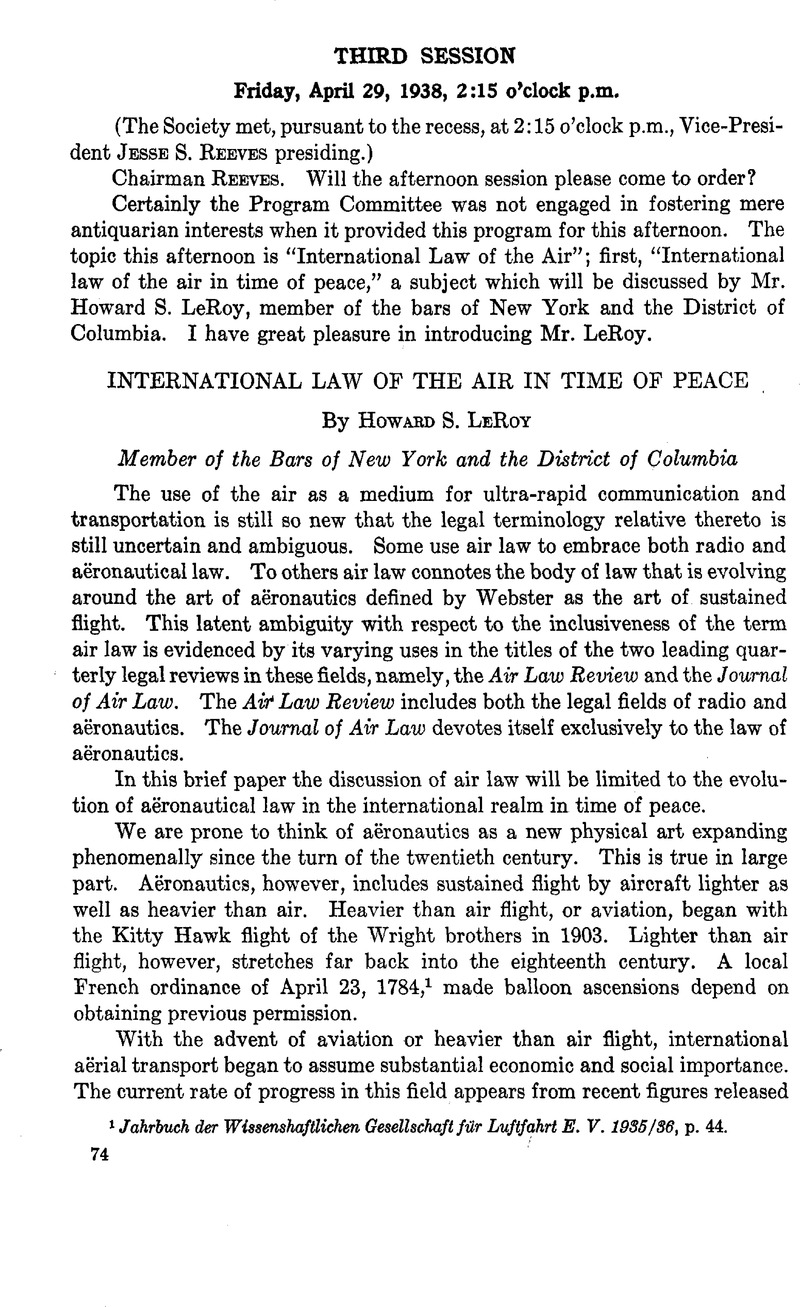No CrossRef data available.
Published online by Cambridge University Press: 27 February 2017

1 Jahrbuch der Wissenshaftlichen Gesellschaft für Luftfahrt E. V. 1935/36, p. 44.
2 Law Notes, April, 1914, p. 5; 18 American Law Reporter, p. 1324.
3 International Air Navigation Convention. Text, annexes and amendments to June, 1924. Washington, Government Printing Office, Dec. 1, 1924.
Examen du Principe de la Convention Internationale Portant Réglementation de la Navigation Aérienne de Oct. 1919, Henri-Couannier, Paris, 1929.Google Scholar
La Convention Internationale du 13 Oct. 1919 portant Réglementation de la Navigation Aérienne, Roper, Paris, 1930; 4 Air Law Rev., p. 348.Google Scholar
The International Air Navigation Conventions and the Commercial Air Navigation Treaties, Fagg, Fred D. Jr., 2 So. Cal. L. Rev., pp. 430–54.Google Scholar
“Deutschland und das Pariser Luftverkehrsabkommen,” Wegerdt, Dr. Alfred, 2 Zeitschrift für das Gesamte Luftrecht, 25 (1928).
“Les Articles 23 et 32 de la Convention du 13 Oct. 1919 et leur Développement Souhaitable,” Bobinski, Il Diritto Aeronautics, 1931, p. 575.
“International Convention for Air Navigation and the Pan American Convention for Air Navigation: A Comparative and Critical Analysis,” Warner, Edward P., 3 Air Law Rev., pp. 221–308, July, 1932.Google Scholar
“Regulation of International Air Navigation under the Paris Convention,” Bouvé, Clement L., 6 Journal of Air Law, pp. 299–324, July, 1935.Google Scholar
4 “Does the Havana Aërial Convention Fulfill a Need?” Cassidy, Louis C, 2 Air Law Rev., pp. 39–43.Google Scholar
“Havana Convention on Commercial Aviation,” Hotchkiss, Henry G., 2 Air Law Rev. p. 254 (note).Google Scholar
5 Department of State Treaty Series, No. 901.
6 Konferencja Waraiawska, Warszawa, 1930.
La Convention de Varsovie, D. Goedhuis, 1933, Nijhoff, The Hague; 4 Air Law Rev. p. 348.
La Convention de Varsovie, Maschino, 1930, Droit Aérien, 4; 4 Air Law Rev., p. 348.
“Zum Warschauer Luftprivatrechtsabkommen Riese, 1930,” 4 Rebel’s Zeitsehrift fuer Auslaendisches und Internationales Privatrecht, 244; 4 Air Law Rev., p. 348.
“International Unification of Private Law Rules on Air Transportation and the Warsaw Convention,” Sack, Alexander N., 4 Air Law Rev., p. 389, Oct., 1933.Google Scholar
“The Warsaw Convention and the C.I.T.E.J.A.,” Latchford, Stephen B., 20 Am. Bar Assn. Jour., p. 753, Dec., 1934.Google Scholar
7 “III International Luftprivatrechtskonferenz Rom. May 1933,” Oppikofer, Hans, 3 Archiv für Luftrecht, p. 220.
La Convention de Rome 29 Mai 1933 pour l’Unification de Certaines Règles Relatives aux Dommages Causés par les Aéronefs aux Tiers à la Surface et les Législations Nationales,” Kaftal, A., Rev. Générale de Droit Aérien, July–Sept., 1934, p. 510.
8 “Multipartite Aërial Agreements,” Gibson, 1931, 5 Temple L. Q., pp. 404–424.
9 “Untested Air Rights in Our Treaties of Friendship, Commerce, and Consular Rights.” Ewing, Hampton D., 4 Air Law Rev., pp. 48–57 Google Scholar.
10 Le C.I.T.E.J.A. Son Origine, Son But, Son Oeuvre, Paris (37 Av. Rapp.), Sudre, 1930 Droit Aérien, p. 31; Ide, 3 Journal of Air Law, p. 27 (1932).
“De l’Organisation Internationale de l’Aviation Civile,” Sudre, Edmond, Secrétaire Générale du C.I.T.E.J.A., Rev. Gén. du Aérien, 1932, p. 1.Google Scholar
“The Warsaw Convention and the C.I.T.E.J.A.,” Latchford, Stephen B., 20 Am. Bar Assn. Journal, p. 753, Dec, 1934.Google Scholar
11 Address delivered by Mr. Stephen Latchford, of the Treaty Division, Department of State, before the Federal Bar Association, Jan. 21, 1936.
1 Article 1 (2) reads as follows:
“1. (2) For the purposes of this Convention the expression ‘international carriage’ means any carriage in which, according to the contract made by the parties, the place of departure and the place of destination, whether or not there be a break in the carriage or a transshipment, are situated either within the territories of two high contracting parties, or within the territory of a single high contracting party, if there is an agreed stopping place within a territory subject to the sovereignty, suzerainty, mandate or authority of another Power, even though that Power is not a party to this Convention. A carriage without such an agreed stopping place between territories subject to the sovereignty, suzerainty, mandate or authority of the same high contracting party is not deemed to be international for the purpose of this Convention.”
2 See United States Foreign Relations, 1921, Vol. 1, pp. 89, 91, 95.
3 See Arts. III and IV, U. S. Statutes at Large, Vol. 42, p. 2151; American Journal of International Law, Supp., Vol. 16 (1922), pp. 96–97.
4 See U. S. For. Rel., 1920, Vol. 1, pp. 159, 161.
5 “Acquisition of Sovereignty over Polar Areas,” Charles Cheney Hyde, Iowa Law Review, Vol. XIX, p. 286; “Who Owns Antarctica,” Charles Cheney Hyde, The Independent Journal of Columbia University, Vol. 3, No. 9; “Political Rights in the Arctic,” David Hunter Miller, Foreign Affairs, Vol. 4, p. 47; “National Rights in Antarctic,” David Hunter Miller, ibid., Vol. 5, p. 508; “Title to Land in Antarctica,” William R. Vallance, Fed. Bar Assn. Journal, Vol. 1, p. 53.
6 S. 3845 was passed by Congress June 13, 1938, Congressional Record, p. 11911.